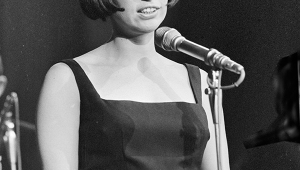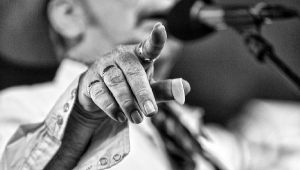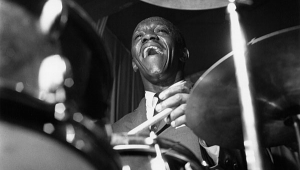| Columns Retired Columns & Blogs |
Intermezzo: The Santa Barbara Sessions
The justification of art is the internal combustion it ignites in the hearts of men.—Glenn Gould
Footnote 1: For more background on Kavi, his recording technique and philosophy, and Water Lily Acoustics, see the interview in Stereophile, September 1989, Vol.12 No.9. You can contact Water Lily Acoustics at P.O. Box 91488, Santa Barbara, CA 93190, Tel: (805) 968-8188.—TJN
"I'm going to bed. See you tomorrow." John Atkinson, Stereophile's editor and our producer for this, the magazine's second recording project, had decided to call it a day. Our recording engineer, Kavichandran Alexander, had just walked into the control room asking if we'd noticed that the left channel was still louder than the right. It was the last of many crises of the night, and we still hadn't done Take One. My day had involved a leisurely Sunday-afternoon drive up from my then home in Los Angeles to report on, and, I hoped, be of some assistance in, the sessions. John had had a longer jaunt, flying in from Santa Fe and arriving that afternoon. Although the first day hadn't exactly been a waste of time (at least we knew where our problems were), it was already past midnight and obvious that we'd all be more productive the next evening. The sessions were scheduled to run three nights, Sunday through Tuesday. A fourth night, Wednesday, was available, but no one (least of all JA, who had the responsibility of putting out a magazine on time to get back to) wanted to use it.

I arrived on that first night about the same time as JA, Larry Archibald, our soloist—noted Canadian pianist Robert Silverman—and a 9' Steinway "D" concert grand piano (supplied by Santa Barbara Music). We were scheduled to record three Brahms piano pieces: the Sonata in f (Op.5), Three Intermezzi (Op.117), and the Rhapsody No.2 in g (Op.79). It was decided very soon after our arrival to delete the latter—a decision which enabled us to finish the sessions on time. The LP release would couple the Sonata with the first Intermezzo, which would provide a fascinating comparison between early and late Brahms; the CD would include all three Intermezzi. The recording location, selected by Kavi Alexander (who is familiar with the Santa Barbara area since he lives nearby and does much of his Water Lily Acoustics recording work there—footnote 1), was the Universalist Unitarian Church of Santa Barbara, a modestly sized, mission-style church on a back street about a mile from downtown. But a busy back street; the sessions were all to be held in the evening to avoid as much traffic noise as possible.
Kavi had brought along his normal complement of decidedly non-normal recording equipment: a ca 1968 Ampex MR70 tape recorder (½", half-track, 15ips—Ampex's last model to use vacuum tubes) used without any noise reduction, and Tim de Paravicini's tube microphones and preamp. An ample supply of Ampex Grand Master 456 recording tape was stockpiled, and Bill Reed (of Nelson-Reed) was on hand to fine-tweak the recorder. Military-grade, non-interruptable power supplies (Behlman battery backups) were also included in the chain, though fortunately a power failure was not to be one of our problems. A good thing, since emergency lighting was in short supply—we had neglected to bring even a candelabra; had we suffered a power failure, the Ampex would have run merrily on with its backup power, while our pianist attempted to feel his way around the keys in the dark. (The battery power could, however, prevent the ruining of a take caused by a very brief power loss.)
Several sets of Stax headphones were available for monitoring—Lambda Pros and SRX IIIs. One set of the latter, Kavi's own, was connected to a Bascom King-designed direct-drive tube amplifier. The remainder were driven by a pair of Stax SRM-1s. The Lambda Pros used by JA for monitoring were also routed through a Stax ED-1 diffuse-field headphone equalizer (reviewed by BS in April 1989, Vol.12 No.4), a device designed to compensate, to a degree, for the spatial differences between headphones and loudspeakers. I had also brought along my aging and trusty, though little used, Nakamichi 582 to record working copies of the sessions. (Kavi prefers not to play the masters any more than is absolutely necessary.) Cassette dubs, recorded in real time from the output of the Ampex, were therefore used to play back the takes for on-scene analysis and for later, post-session review, to determine which takes John Atkinson and editor Hugh Davies would use in the final assembly.
Footnote 1: For more background on Kavi, his recording technique and philosophy, and Water Lily Acoustics, see the interview in Stereophile, September 1989, Vol.12 No.9. You can contact Water Lily Acoustics at P.O. Box 91488, Santa Barbara, CA 93190, Tel: (805) 968-8188.—TJN
- Log in or register to post comments



































